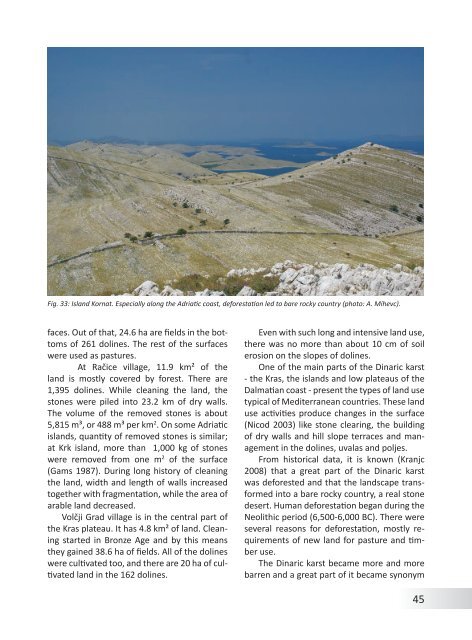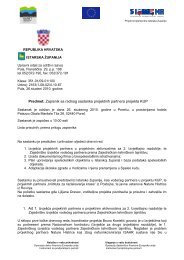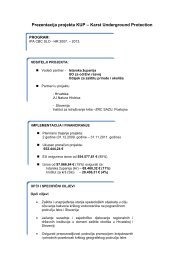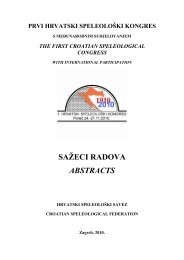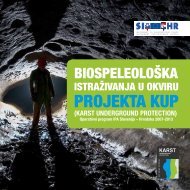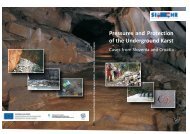Case Studies from the Dinaric Karst of Slovenia
Case Studies from the Dinaric Karst of Slovenia
Case Studies from the Dinaric Karst of Slovenia
Create successful ePaper yourself
Turn your PDF publications into a flip-book with our unique Google optimized e-Paper software.
Fig. 33: Island Kornat. Especially along <strong>the</strong> Adriatic coast, deforestation led to bare rocky country (photo: A. Mihevc).faces. Out <strong>of</strong> that, 24.6 ha are fields in <strong>the</strong> bottoms<strong>of</strong> 261 dolines. The rest <strong>of</strong> <strong>the</strong> surfaceswere used as pastures.At Račice village, 11.9 km² <strong>of</strong> <strong>the</strong>land is mostly covered by forest. There are1,395 dolines. While cleaning <strong>the</strong> land, <strong>the</strong>stones were piled into 23.2 km <strong>of</strong> dry walls.The volume <strong>of</strong> <strong>the</strong> removed stones is about5,815 m³, or 488 m³ per km 2 . On some Adriaticislands, quantity <strong>of</strong> removed stones is similar;at Krk island, more than 1,000 kg <strong>of</strong> stoneswere removed <strong>from</strong> one m 2 <strong>of</strong> <strong>the</strong> surface(Gams 1987). During long history <strong>of</strong> cleaning<strong>the</strong> land, width and length <strong>of</strong> walls increasedtoge<strong>the</strong>r with fragmentation, while <strong>the</strong> area <strong>of</strong>arable land decreased.Volčji Grad village is in <strong>the</strong> central part <strong>of</strong><strong>the</strong> Kras plateau. It has 4.8 km² <strong>of</strong> land. Cleaningstarted in Bronze Age and by this means<strong>the</strong>y gained 38.6 ha <strong>of</strong> fields. All <strong>of</strong> <strong>the</strong> dolineswere cultivated too, and <strong>the</strong>re are 20 ha <strong>of</strong> cultivatedland in <strong>the</strong> 162 dolines.Even with such long and intensive land use,<strong>the</strong>re was no more than about 10 cm <strong>of</strong> soilerosion on <strong>the</strong> slopes <strong>of</strong> dolines.One <strong>of</strong> <strong>the</strong> main parts <strong>of</strong> <strong>the</strong> <strong>Dinaric</strong> karst- <strong>the</strong> Kras, <strong>the</strong> islands and low plateaus <strong>of</strong> <strong>the</strong>Dalmatian coast - present <strong>the</strong> types <strong>of</strong> land usetypical <strong>of</strong> Mediterranean countries. These landuse activities produce changes in <strong>the</strong> surface(Nicod 2003) like stone clearing, <strong>the</strong> building<strong>of</strong> dry walls and hill slope terraces and managementin <strong>the</strong> dolines, uvalas and poljes.From historical data, it is known (Kranjc2008) that a great part <strong>of</strong> <strong>the</strong> <strong>Dinaric</strong> karstwas deforested and that <strong>the</strong> landscape transformedinto a bare rocky country, a real stonedesert. Human deforestation began during <strong>the</strong>Neolithic period (6,500-6,000 BC). There wereseveral reasons for deforestation, mostly requirements<strong>of</strong> new land for pasture and timberuse.The <strong>Dinaric</strong> karst became more and morebarren and a great part <strong>of</strong> it became synonym45


